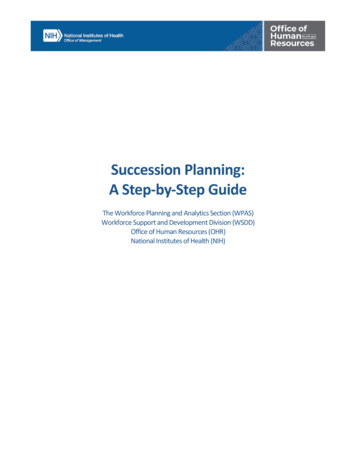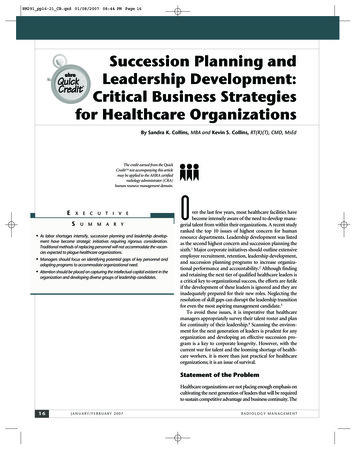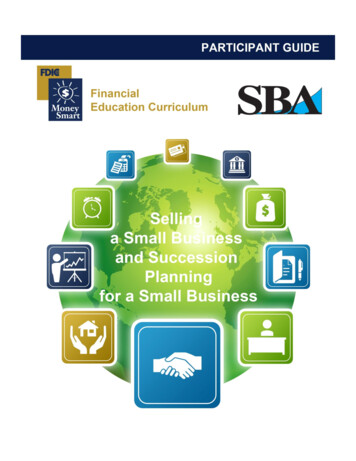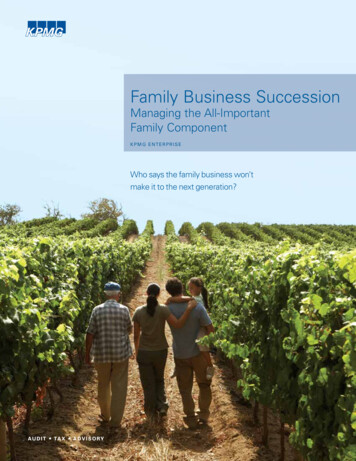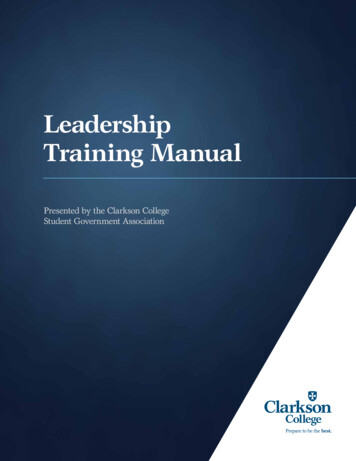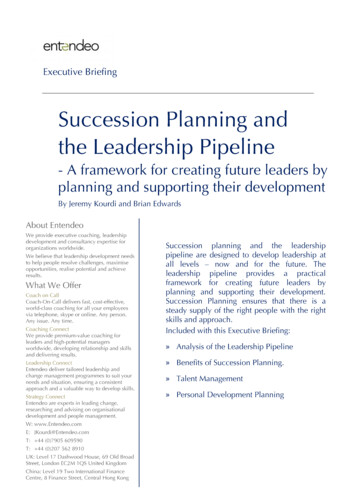
Transcription
Whatever your business, location or situation, having the rightpeople in the right roles is essential for success.»»»»Introduction
Good employees are hard to find and with declining populations indeveloped western countries, it is becoming harder and more competitive tofind talented people with the right attitude and skills. The solution issuccession planning – the ability to deploy the specific capabilities in theright place at the right time. It also requires talent management: attracting,developing and retaining the right people. Nurturing, developing andretaining the most talented people requires constant attention and action inseveral ways – this checklist explains how to ensure success.The Leadership PipelineWhat does it do? Provides a framework for leadership developmentExplains what success looks like at each stageDescribes how to improve skills – from newcomers to top executivesEnsures consistency across the businessExplains how to prepare for career advancementWhy is it valuable?The leadership pipeline improves the performance of individuals, teams and,consequently, the whole organization. It meets three vital business needs:The leadership pipeline: Provides clarity about what is required at different leadership levels. Ensures the right development is accessible for all, helping people tounderstand the development that is needed at different stages of theircareer. Focuses the organization’s development activities. The leadershippipeline is used to ensure that development activities are focused,accessible and relevant.How it worksThere are six stages in the leadership pipeline:1. Self-leadership: individuals are responsible for their own effectiveness,development and results.2. Leading others: individuals are responsible for the work of other people.3. Leading managers: individuals are responsible for the work of othermanagers.4. Leading leaders: individuals are responsible for the delivery of part of abusiness.5. Leading a business: individuals are accountable for the results of abusiness.6. Leading your organization: individuals are responsible for more than onebusiness.»Executive BriefingSuccession Planning and The Leadership Pipeline2
Where am I in the Leadership Pipeline?The following questionnaire is a quick, easy way to give you an indication ofyour stage on the leadership pipeline. Decide which statement applies to youin each section, and note your responses by circling a, b, c, d or e. At the end,read the paragraph that represents the majority response and reflect on yourposition in the leadership pipeline.1 I typically A.2 I typically amanage my own performance.aplan my own work.bmanage the performance of abplan and allocate the work ofteam.cothers.manage the performance of othercmanagers who manage teams.assign managerial work tomanagers within my team for themto plan.demanage and lead a business,dam involved in strategic planningfocusing on business strategy andfor the department or function infinancial awareness.which I work.manage and lead a business,ebuilding cross-business unitdefine strategy and drive thebusiness.value, taking full accountabilityfor P&L.3 Primarily, I aam responsible for my own4 It’s important in my role that I adevelopment.bcoach and develop a team.build local relationships forpersonal results and benefits.bbuild relationships external to theteam.cdevelop managers to develop andccoach their teams to supportwork horizontally across thebusiness.business delivery.dam responsible for managingdlonger-term talent and peoplebuild networks across theorganisation.development in my unit.eam accountable for longer-termetake accountability for internal andtalent and people development ofexternal stakeholder managementthe business.relevant to the organisation.»Executive BriefingSuccession Planning and The Leadership Pipeline3
5 I typically aget results through personal proficiency and individual delivery.bget results through leading and developing others.cget results through setting direction and leading managers to deliverthrough their teams.dget results through creating, selling or delivering a service and settingstrategy to deliver this.eget results through building cross-business unit value and driving thebusiness.ResultsMostly As – Self Leadership, focusing on: personal identity; developingindividual expertise, and learning from mentors, peers and from yourmanager.Mostly Bs – Leading Others, focusing on: professional identity; planning,organizing and integrating expertise; developing influence andinterdependence; coaching; developing engagement and team commitment,and working through others.Mostly Cs – Leading Managers, focusing on: developing leadership identity;ensuring cross-functional integration; displaying vision and authority;generating organizational commitment, and learning from mistakes.Mostly Ds – Leading Leaders, focusing on: business identity; buildingreputation and authority; dealing with increasing complexity; having apivotal role in enterprise structure, and dealing with less visibleopportunities.Mostly Es – Leading a Business or Leading the Organization. BusinessLeadership is about organizational identity, risk-taking, creating alliances,creating competitive advantage, cross business value creation and learningfrom the competition. Leading the organization is about enterprise identity,vision and strategy, company legacy, shaping culture, creating organizationalsynergy, managing enterprise alliances, creating shareholder value andlearning from sharing wisdom.BenefitsFor individuals, the leadership pipeline: supports improved performance and development plans increases understanding of development options provides clarity about what is expected for each transition helps articulate future opportunities provides a basis for developing performance helps explain what is required for great performance»Executive BriefingSuccession Planning and The Leadership Pipeline4
For line managers, the leadership pipeline: supports performancemanagement and development conversations; increases understanding ofdevelopment issues and priorities.For the organization, the leadership pipeline: supports end-to-end leadership development planning helps develop future leadership enables people to perform at their best clarifies leadership challenges and the support required helps people (individuals and managers) understand issues affectingperformance and roles promotes consistency across the organization»Executive BriefingSuccession Planning and The Leadership Pipeline5
Overview of each stage in the leadership pipelineWhat skills are requiredWhat will individuals doWhat do individuals value atWhat should people do toduring this stage?during this stage?this stage?prepare for the future? »Executive BriefingSuccession Planning and The Leadership Pipeline6
What skills are requiredWhat will individuals doWhat do individuals value atWhat should people do toduring this stage?during this stage?this stage?prepare for the future? »Executive BriefingSuccession Planning and The Leadership Pipeline7
What skills are requiredWhat will individuals doWhat do individuals value atWhat should people do toduring this stage?during this stage?this stage?prepare for the future? »Executive BriefingSuccession Planning and The Leadership Pipeline8
What skills are requiredWhat will individuals doWhat do individuals valueWhat should people do toduring this stage?during this stage?at this stage?prepare for the future? »Executive BriefingSuccession Planning and The Leadership Pipeline9
What skills are requiredWhat will individuals doWhat do individuals value atWhat should people do toduring this stage?during this stage?this stage?prepare for the future? » Executive BriefingSuccession Planning and The Leadership Pipeline10
Talent ManagementThe term talent management was coined by McKinsey & Company followinga 1997 research study and it was featured in the book The War for Talent byEd Michaels, Helen Handfield-Jones and Beth Axelrod. Talent managementand succession planning are the essence of leadership. The benefits of talentmanagement and succession planning include ensuring a steady supply ofskills, business continuity and the ability to attract and retain the bestemployees – those that will make the greatest difference and bring thegreatest benefit.It is often said – perhaps too often – that people are an organization’sgreatest resource. Whether this is true or not may depend on theorganization but they are certainly the resource with the greatest potentialand the one that is invariably expensive, decisive and critical to a business’scontinued success. Given this fact, their needs, skills and priorities need to beintegrated with the business. It is the task of the leader to help peopleachieve this potential. Clearly, this benefits the individual but it also benefitsthe leader, their team and the whole organization.The best businesses understand that talented, results-driven employees arethe difference between them and their competitors. Research conducted bythe Economist Intelligence Unit in 10 countries found that talentmanagement is an indispensable source of competitive advantage. This isbecause talented executives: Plan and execute strategy better Create a positive work environment – with greater innovation, flexibility,teamwork and collaboration Achieve the benefits of employee engagement, including greaterproductivity and revenue growthIf current and potential leaders have the right skills and experience thentheir direct reports and middle managers will also thrive. In addition, talentmanagement increases job satisfaction and improves retention rates. This isvitally important at a time when competition for strong managers is fierceand growing. Talent management also helps improve succession planning,ensuring that firms have the right people in the right roles, at the right time.A fundamental part of talent management is recognizing the fact thattalented people are a vital, scarce and often neglected resource. In a businesswith limited resources and opportunities, and faced with intensecompetition, it makes sense to give priority to those with the greatest abilityand potential.Talent assessment and entry to the talent poolThis means identifying those individuals with the leadership capability andpotential to undertake complex roles. This assessment may be made by apanel comprising, for example, the individual’s line manager, the head of thebusiness area, a senior HR professional and an independent consultant whoprovides 360-degree feedback. At the panel meeting, members make anevaluative judgement of an individual’s potential, focusing on five elements:»Executive BriefingSuccession Planning and The Leadership Pipeline11
Performance historyCapability ratingsPersonal aspirationsThe ability to progressReadiness to move to a new roleThe talent propositionThis supports accelerated career development for talent pool members andit often combines a bespoke career path with specific and targeteddevelopment opportunities.The talent contractMembership of the talent pool confers a wide range of benefits on eachmember, designed to support and accelerate career progression and toenable each individual to succeed. The benefits of membership should beexplained and agreed, together with details of the responsibilities andexpectations. These benefits and responsibilities then comprise eachmember’s contract with the business.The benefits of talent pool membership for individuals typically include: abespoke career path with active, practical support for career progression;job roles that meet members’ specific development needs; a personaldevelopment plan, providing access to a suite of learning opportunities;feedback on performance; progression that is transparent, open, honest anddirect; access to senior members of staff for advice and career coaching, andthe opportunity to develop a network of contacts to inform and guide careerchoices.The responsibilities of talent pool membership include active careermanagement (preparing and implementing personal development plans);receiving regular feedback, designed to support and encourage a sustainedlevel of performance that most employees do not achieve, and willingness toundertake challenging roles and to make the most of the opportunitiesavailable within the business.Ongoing assessment and segmentationThis ensures that the talent pool’s resources are being focused on the rightpeople, in the right way, to provide the greatest benefit. The goal of the talentpool and the way in which success is judged, is to have people ready to moveinto vital roles as required. Assessment helps check that this is happening.Talent pool members may be assessed as: 1) green, with their career plan ontrack or moving faster than planned; 2) amber, the career plan is partially ontrack but action is required to get back on track within three to six months,with a strong sense that this is achievable, or 3) red – when the career planand succession readiness are off track. The individual needs to review andrecalibrate their progress.Typically, there are several concerns about talent pools and succession plansthat may need to be addressed.»Executive BriefingSuccession Planning and The Leadership Pipeline12
Potential problem or challengePossible solutionCareer counselling and support for members of the talent poolIt is valuable for managers and HR professionals to provide career counselling andhelp to create a bespoke career path for each talent pool member. This career pathshould: Include clearly-identified milestones, explaining what is expected of the talentpool member at 12, 24 and 36 months Take full account of each individual’s career aspirations Be explained to the individual’s line manager (and their business unit head, ifdifferent)»Executive BriefingSuccession Planning and The Leadership Pipeline13
In addition, it is valuable for an HR professional to meet at regular, agreedintervals with each member of the talent pool to provide support. This mayinclude brokering leadership-development programmes and schedulingdevelopment activities.Coach talent pool members using the GROW modelCoaching has four main phases:1. Set goals both for the overall coaching relationship and for the individualsession2. Explore the current position of the learner: the reality of their circumstancesand their concerns3. Generate strategies, action plans and options for achieving the goals outlinedabove4. Decide what is to be done, by whom, how and whenThis is aptly known as the GROW model (an acronym reflecting the Goals,Realities, Options and What/Will phases of the process). The central element isthat responsibility for setting the goals ultimately rests with the learner. Goals setby others are more likely to be wrong, inappropriate, set too high or low and lackthe commitment of the learner.The main objective of the mentor or coach is to help the learner through thisprocess, chiefly by using effective questioning, rather than by instruction orreminiscing. The goals established should cover both the long-term (what thelearner hopes to achieve in the next twelve months with the coach/mentor’ssupport) and the immediate purpose of the coaching/mentoring session.Talent management roles and responsibilitiesIndividualRoles and responsibilities »Executive BriefingSuccession Planning and The Leadership Pipeline14
IndividualRoles and responsibilities Support Personal Development PlanningPersonal development planningThe next stage is to write the personal development plan and this should includethe following headings and information. Situational analysis ('Where am I now?') Personal objectives ('Where do I want to be?') Strategy ('How am I going to get there?')»Executive BriefingSuccession Planning and The Leadership Pipeline15
Also, consider how best to resolve or overcome any impediments (personal orprofessional) to achieving your desired outcome – and take action. Include detailsof your planned activities: development objectives, activities, details of when theywill be completed, any support needed and when progress will be reviewed.It is the talent pool member’s responsibility to implement their action plan. Theyshould consider how the development activity will be supported, perhaps by amentor within the organization, and how the results will be integrated intoworkplace activities.Follow the self-development cycleThe self-development cycle is a method of focusing, planning and undertakingdevelopment activities in a rigorous, thorough and practical way. The success ofthe personal development cycle depends on repeating the planning processregularly, at least every year, preferably every six months, or when circumstanceschange, such as taking on a new role. The seven stages of the cycle are:1. Establish the purpose. You need to keep the overall aim firmly in mind and thenensure that all activities directly support this aim. Without this clear goal inmind, it is often difficult to stay on track, keep momentum or maintainmotivation.2. Identify development needs. The development needs must be identified and aprogramme for meeting those needs should be devised. In particular, the needsmust be realistic and time-constrained, with a definite deadline.3. Look at your opportunities for development. Deciding how to meet thedevelopment needs is the next stage, and this may include a mix of formal andinformal methods. As well as effectiveness, cost and timing, bear in mind yourown preferred learning style: what approach suits you best?4. Formulate an action plan. This will be necessary for more complex developmentneeds requiring a range of activities or an ongoing process. You should alsoconsider how to support the development process will be supported, perhapsby a mentor.5. Undertake development. This is the core of the process. It is worth consideringspecifically how the results will be integrated into workplace activities.6. Record outcomes. Keep track of development activities in order to assess resultsagainst planned objectives (reviewing progress and understanding whatmethods work best) and plan future activities.7. Review and evaluate. The process of recording and evaluating is oftencompleted using a Personal Development Log; evaluating an event will help toassess whether the original objective has been met and the development needfulfilled. You should evaluate: The development activity: whether it met your needs and was useful The knowledge, skills and understanding that you gained How the activity will make a difference in the workplace The next steps: for example, the activity might have highlighted further areasfor development or additional tasks that can be completed»Executive BriefingSuccession Planning and The Leadership Pipeline16
Things You Can DoExplain why talent management mattersCultures that nurture talent have several valuable characteristics. Ensuring thatthese are understood enables people (employees and leaders) to buy-in to theneed for talent management and to begin to understand what they need to do. Teams are highly cohesive Authority resides with expertise and ability, not status Talented individuals acknowledge the support they receive from others Talented people possess skills of critical analysis: they challenge and do notfollow blindly Leadership is highly respected Talented teams display freedom, autonomy, space, flexibility, openness andtrust Risk-taking is encouraged Success for talented people goes beyond the bottom lineIt is important that succession planning is actively embraced and valued by seniorexecutives. It should be integrated into training and development activities, andthe board should oversee the management of the process and the progress beingachieved. Executives should be encouraged to get to know successful, highpotential individuals; they should be able to gauge the likely effectiveness of theleadership pipeline and they should provide individuals with the benefit of theirtime, insights and experience (e.g. via a mentoring programme).Develop and communicate principles for talent managementSeveral guiding principles are valuable when establishing a talent pool. Eachorganization needs to develop their own, however it may be useful to establish thefollowing principles: Rigorous, standard procedures for assessing and developing talent (includingpersonal development plans) A consistent approach to engaging and supporting talent A meritocratic approach that recognises the value of diversity A globally-consistent standard for recording and reporting data A clear, practical framework to measure successManage the head, heart and handsTalent management requires a rational, consistent process that clearly engageswith each individual’s intelligence and their ability to learn and develop. Twoother elements are also important: the heart (the need to appeal to a person’spassions and intrinsic motivation) and the hands (the ability for an individual totake what they know and control and shape it). Building an environment thatencourages these three elements simultaneously can be accomplished in severalways.»Executive BriefingSuccession Planning and The Leadership Pipeline17
Carefully match employees with objectives, projects and the work they aredoing. Give them a challenge at the top of their skill level, so they will continueto develop Provide adequate resources – enough to ensure that plans can be implemented Empower them with freedom and control over their work, as well as the timeand latitude to pursue their ideas Send the right signals, recruiting the right type of people and allowing people towork in their own way, even if it is highly individualInspire trustBuilding trust with talented individuals is vital. It can be accomplished byrepeating each stage in the trust cycle in sequence:Diagram: The Trust CycleMissing one stage takes you back to the start and makes it harder to build trust inthe future. Trusted leaders hold certain values, behave in certain ways and docertain things. Create an expectation of trust. Leaders who cultivate trust work hard to retainit. Trust others. The best leaders trust people and believe that individuals want todo the job well. This tends to be a self-fulfilling prophecy. Also, ensure yourintent is clear and honest, without hidden agendas. Trusted leaders are open. Genuinely, have the business’s interests at heart. Trusted leaders want to leavea legacy and build something far beyond their tenure with the company. Be consistent. This means treating people fairly and upholding standards ofbehaviour and performance. Your values and principles should be so clear thatpeople are able to predict your response. Confront people, without being confrontational. We trust someone who we canrely on, yet leaders can fall down when tackling performance issues incorrectly,undermining their credibility.»Executive BriefingSuccession Planning and The Leadership Pipeline18
Let others see your passion and what you care about. People will be much moreinspired to follow you if it's obvious that you truly care about the project,company or product. Trusted leaders speak from the heart, not just from theirintellect. Admit when you don't know. Trusted leaders don't mind talking about theirvulnerabilities or admitting when they are wrong. We tend to be suspicious ofpeople who act as though they are always right, who think they know all theanswers and who won't admit mistakes. Behave with integrity – being honest, keeping confidences and promises andrespecting others. Use power positively. Trusted leaders are interested in power only because itwill enable them to do the right thing, not to support their ego. They use powerfor productive reasons.Behaving this way means that people are better informed and focused on doingthe right things. Also, less time is wasted and problems are identified and solvedearly. Finally, remember that trust is not a temporary ‘quick fix’ approach we canuse when it suits us and discard when we choose. It is a genuine belief system. Wedon’t trust people for our own gain. We trust them because it is the right thing todo – and, in the end, we all benefit.Dos and Don’tsDo: Involve line managers and senior executives in identifying and managing themost talented people Be clear about the skills and behaviours needed for the organization’s longterm development Agree a ‘contract’ for talent pool members Be patient and manage expectations Integrate talent management with succession planning, and ensure that bothdirectly support the business strategy Maintain top level support for the talent pool and succession plans Invest in talent management – it is vital for the futureDo not: Ignore individual performance issues among talent pool members – find waysto resolve them Be inflexible – a contract is vital but it should also have the flexibility to adjustto specific circumstances Forget the rest of the business. Pre-empt resentment by communicating andproviding opportunities for talent pool members to share their expertise andbuild links Leave failing performers in the talent pool. Take action to ensure that the talentpool remains relevant and effective»Executive BriefingSuccession Planning and The Leadership Pipeline19
A final thought.If, as it is often said, individuals don’t leave an organization – they leave a boss,then there is a more encouraging aspect to this: using succession planning toensure that there is a steady supply of strong leaders with the right skills, willmake each employee’s situation more positive and they will be more inclined tostay and give their best. The leadership pipeline improves the performance ofindividuals, teams and, consequently, the whole organization.Article edited by Stephanie Edwards»Executive BriefingSuccession Planning and The Leadership Pipeline20
»Executive BriefingSuccession Planning and The Leadership Pipeline1
Focuses the organizations development activities. The leadership pipeline is used to ensure that development activities are focused, accessible and relevant. How it works There are six stages in the leadership pipeline: 1. Self-leadership: individuals are responsible
